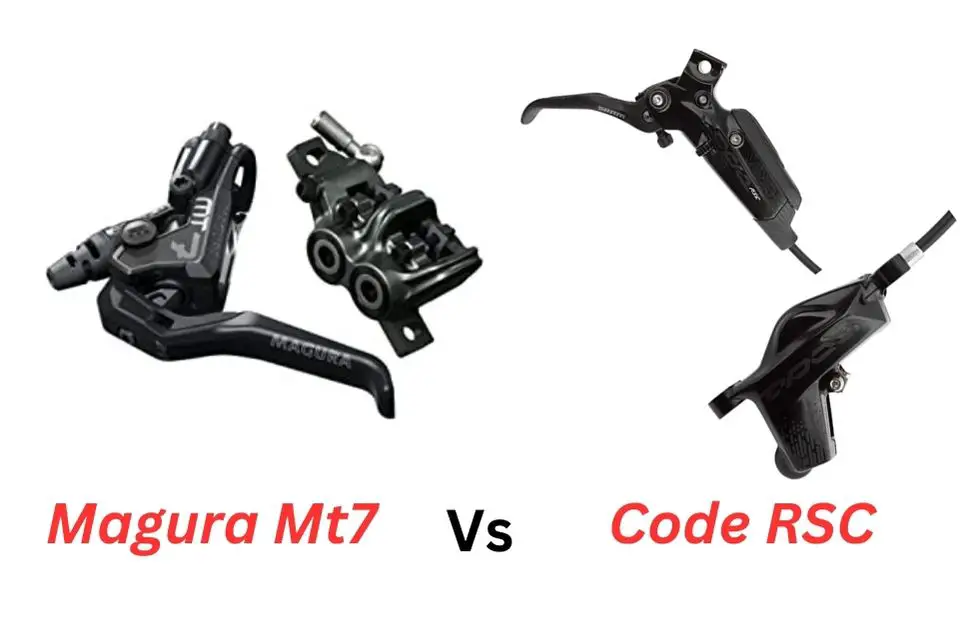
When it comes to mountain biking, having reliable and high-performance brakes is crucial for ensuring safety and control on the trails. Two popular options that often come up in discussions are the Magura MT7 and Code RSC brakes.
Magura MT7 brakes have gained a reputation for their exceptional braking power and precise modulation. They are widely regarded as one of the top choices for downhill and enduro riders who demand uncompromising performance from their brakes.
As Code RSC brakes, produced by SRAM, have also garnered significant attention in the mountain biking community. Known for their impressive stopping power and solid lever feel, they are favored by riders tackling aggressive trails and demanding terrains.
Throughout this post, we will explore various aspects such as design and features, braking performance, heat management, durability, weight, maintenance requirements, pricing, and more.
Please continue reading as we delve into the design and features of these two exceptional hydraulic disc brake systems.
Magura MT7 vs Sram Code RSC Brakes
When it comes to high-performance hydraulic disc brakes for mountain bikes, the Magura MT7 and Code RSC brakes are among the top contenders. Let’s take a closer look at each brake system:
Magura MT7 Brakes:
The Magura MT7 brakes have earned a solid reputation in the mountain biking community for their outstanding performance and precise control.
Designed with downhill and enduro riders in mind, these brakes offer exceptional stopping power and modulation, allowing riders to confidently navigate steep descents and technical sections.
The Magura MT7 brakes feature a robust and reliable construction. They utilize a four-piston caliper design, which maximizes braking force and provides excellent heat dissipation.
The lever design incorporates ergonomics and adjustability, allowing riders to fine-tune their brake lever position according to their preferences.
Code RSC Brakes:
The Code RSC brakes, manufactured by SRAM, are renowned for their formidable stopping power and solid lever feel. These brakes are favored by riders who demand precise control and reliability when tackling aggressive trails and challenging terrain.
The Code RSC brakes also utilize a four-piston caliper design, providing ample stopping power to handle intense riding situations. The lever design incorporates a blend of ergonomics and adjustability, offering riders a comfortable and customizable lever feel.
The reach adjustment allows for easy personalization, ensuring riders of different hand sizes can find the perfect brake lever position.
Design and Features
To understand the differences between the Magura MT7 and Code RSC brakes, it’s important to examine their design and key features. Let’s explore these aspects in detail:
Magura MT7 Brakes Design and Features:
The Magura MT7 brakes are known for their robust construction and thoughtful design elements. Here are some key features of the Magura MT7 brakes:
Four-Piston Caliper:
The MT7 brakes utilize a four-piston caliper design, which enhances braking power and provides consistent performance even during prolonged descents. The larger piston size allows for greater force transmission, resulting in exceptional stopping power.
Lever Design:
The Magura MT7 lever incorporates ergonomic design principles, ensuring rider comfort and control. The lever reach can be easily adjusted to accommodate different hand sizes, promoting optimal lever positioning for enhanced modulation and grip.
Pad Contact Adjustment:
One notable feature of the Magura MT7 brakes is the pad contact adjustment. Riders can fine-tune the engagement point of the brake pads, tailoring the lever feel and responsiveness to their preference. This feature offers a high degree of customization, allowing riders to achieve the desired braking response.
Heat Management:
The Magura MT7 brakes are designed to manage heat effectively, thanks to their optimized caliper and rotor design. This feature helps maintain consistent performance and prevents brake fade, even during prolonged downhill descents or intense riding sessions.
Read Also: Magura MT5 vs. Shimano XT: Compared
Code RSC Brakes Design and Features:
The Code RSC brakes from SRAM also boast a well-engineered design with several notable features. Here’s a closer look at the design elements and features of the Code RSC brakes:
Four-Piston Caliper:
Similar to the Magura MT7 brakes, the Code RSC brakes feature a four-piston caliper design. This design ensures powerful braking performance and consistent modulation, enabling riders to tackle challenging trails with confidence.
Lever Design:
The Code RSC lever design focuses on providing a solid lever feel and ergonomic comfort. Riders can adjust the lever reach to suit their hand size and riding preferences, ensuring a comfortable and controlled grip on the brake lever.
Pad Contact Adjustment:
The Code RSC brakes also offer pad contact adjustment, allowing riders to fine-tune the engagement point and customize the lever feel. This adjustability contributes to better control and modulation, enabling riders to optimize their braking performance.
Heat Management:
Heat dissipation is a critical factor for sustained braking performance, and the Code RSC brakes are designed with effective heat management in mind. The caliper and rotor design promote heat dissipation, preventing brake fade and maintaining consistent performance, even during intense riding conditions.
Read Also: Magura MT5 vs. Shimano Slx: Compared
Performance and Control
When it comes to mountain bike brakes, performance and control are paramount. In this section, we will examine the braking performance, power, and overall control offered by the Magura MT7 and Code RSC brakes.
Magura MT7 Brakes Performance and Control:
The Magura MT7 brakes are widely acclaimed for their exceptional performance and precise control. Here are some key factors to consider:
Braking Performance:
The Magura MT7 brakes excel in delivering powerful and consistent braking performance. The four-piston caliper design, combined with the larger piston size, provides ample stopping power to handle steep descents and demanding trail conditions. Riders can rely on the MT7 brakes to bring their bikes to a halt effectively and safely.
Modulation:
Modulation refers to the ability to control the braking power with precision. The Magura MT7 brakes are known for their excellent modulation, allowing riders to finely tune their braking force according to the terrain and riding style. This modulation helps maintain control and traction, especially in technical sections where precise speed adjustments are crucial.
Overall Control:
With the Magura MT7 brakes, riders can enjoy a high level of control. The ergonomic lever design, along with the adjustable lever reach, ensures a comfortable and intuitive grip. The pad contact adjustment feature enables riders to fine-tune the engagement point, further enhancing control and responsiveness.
Code RSC Brakes Performance and Control:
The Code RSC brakes from SRAM are designed to deliver exceptional performance and control in aggressive trail riding scenarios. Consider the following aspects:
Braking Performance:
The Code RSC brakes are renowned for their impressive stopping power. The four-piston caliper design, combined with optimized pad materials, allows for quick and controlled deceleration. Riders can rely on the Code RSC brakes to deliver consistent and reliable braking performance, even in challenging conditions.
Modulation:
Similar to the Magura MT7 brakes, the Code RSC brakes offer excellent modulation capabilities. This enables riders to finely adjust their braking power, helping maintain control, especially in technical sections or when navigating tricky obstacles. The Code RSC brakes provide a responsive and intuitive braking experience.
Overall Control:
With the Code RSC brakes, riders can expect solid lever feel and enhanced control. The ergonomic lever design, coupled with adjustable reach, ensures riders of various hand sizes can find a comfortable and ergonomic lever position. This promotes confident and controlled braking, allowing riders to maneuver their bikes precisely.
Read Also: 7 Compact Mountain Bike Accessories
Heat Management and Durability
Heat management and durability are crucial factors to consider when evaluating mountain bike brakes. In this section, we will examine how the Magura MT7 and Code RSC brakes handle heat and their overall durability.
Magura MT7 Brakes Heat Management and Durability:
Heat Management:
The Magura MT7 brakes are designed to excel in heat management. The caliper and rotor design, combined with the use of advanced materials, aid in dissipating heat generated during intense braking. This helps prevent brake fade, ensuring consistent performance even during long descents or prolonged braking periods.
Durability:
Magura is known for producing durable and reliable braking systems, and the MT7 brakes are no exception. They are built to withstand the rigors of aggressive riding and challenging trail conditions. The robust construction and high-quality materials used in the MT7 brakes contribute to their durability, providing riders with a long-lasting braking solution.
Code RSC Brakes Heat Management and Durability:
Heat Management:
The Code RSC brakes prioritize effective heat management to maintain optimal performance. The caliper and rotor design, along with heat-dissipating materials, work together to dissipate heat and prevent brake fade. This allows riders to tackle demanding trails without compromising braking power or modulation.
Durability:
The Code RSC brakes are engineered to withstand the demands of aggressive riding. SRAM employs durable materials and robust construction methods to ensure longevity and reliability. The Code RSC brakes are built to handle the stresses of intense riding conditions, making them a durable option for riders seeking long-lasting braking performance.
Weight, Maintenance, and Pricing
Weight, maintenance requirements, and pricing are key considerations when comparing the Magura MT7 and Code RSC brakes. Let’s explore these factors in detail:
Weight:
Magura MT7 Brakes:
The Magura MT7 brakes are known for their lightweight construction. The use of high-quality materials and efficient design contributes to their relatively low weight, making them an appealing choice for riders seeking to reduce overall bike weight.
Code RSC Brakes:
The Code RSC brakes also offer a favorable weight-to-performance ratio. While they may not be the lightest option on the market, their weight is still competitive, considering the robustness and durability they provide.
B. Maintenance:
Magura MT7 Brakes:
The Magura MT7 brakes are designed with ease of maintenance in mind. The system features user-friendly bleeding procedures, allowing riders to perform maintenance tasks without extensive technical knowledge. Regular inspection and adjustment of brake pads and rotors are recommended to ensure optimal performance.
Code RSC Brakes:
The Code RSC brakes also offer straightforward maintenance requirements. SRAM provides detailed documentation and resources to guide riders through the maintenance process. Regular checks and adjustments of brake pads and rotors are necessary to maintain peak performance.
Pricing:
Magura MT7 Brakes:
The Magura MT7 brakes are positioned as a premium braking system, and their pricing reflects that. As a high-performance option with exceptional features, the MT7 brakes tend to be priced at the higher end of the spectrum. However, the investment in these brakes often pays off with their outstanding performance and durability.
Code RSC Brakes:
The Code RSC brakes offer a competitive pricing range. They are priced slightly lower compared to the Magura MT7 brakes while still providing excellent performance and durability. The Code RSC brakes represent a solid value for riders seeking reliable braking without breaking the bank.
Conclusion
When considering your decision, take into account factors such as the specific needs of your riding style, preferences for modulation or powerful stopping, weight considerations, maintenance requirements, and pricing. Each brake system has its own strengths, and the right choice ultimately depends on your individual priorities and riding preferences.
